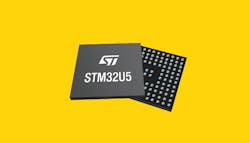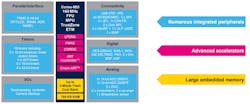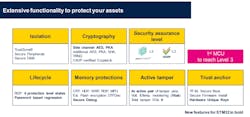ST Introduces New Series of Ultra-Low-Power MCUs
>> Electronic Design Resources
.. >> Top Stories of the Week
.. .. >> Embedded World 2021
STMicroelectronics rolled out a new flagship series of ultra-low-power microcontrollers (MCUs) with upgrades in performance, security, graphics, and peripherals for consumer and industrial IoT devices.
The company said the STM32U5 pumps out more performance per watt than its predecessor, while integrating a rich range of interfaces and internal memory. The central improvement is that it uses the 40-nanometer node, upgrading frm the 90-nanometer node used in its previous generation of chips. The STM32U5 series is based on Arm's Cortex-M33 core clocked at 160 MHz and uses advanced power-saving features to operate up to 90% less power than rival chips, ST said.
ST said its lineup of STM32 microcontrollers, based on Arm's energy-efficient Cortex-M architecture, is used in billions of electronic devices, and that it commands more than 25% of the market for ultra-low-power microcontrollers, where it competes with NXP Semiconductors and Renesas Electronics, among others. It introduced the STM32U5 MCUs ahead of the virtual Embedded World trade show.
The chip's power-saving features include an “autonomous mode” that lets direct memory access (DMA)—which allows components on the chip to access system memory independent of the CPU—and other peripherals to run while the STM32U5 is in standby mode, reducing power in the process. The STM32U5 MCUs also inherited power-saving features from its previous generation of chips.
Among them are “dynamic voltage scaling," which boosts or reduces power use depending on the workload. As opposed to embedded processors, microcontrollers tend to run directly from on-chip flash. But the STM32U5 series uses ST's proprietary adaptive real-time (ART) accelerator to fetch instructions from internal flash memory faster and more efficiently, giving it a performance boost.
The microcontroller packs 2 MB of flash memory and 786 kB of SRAM, improving performance and allowing it to fit larger machine-learning models over its predecessor. The company said it features 512 kB of high-endurance flash, too, that lasts up to 100,000 read-write cycles. ST said customers can use the longer-lasting memory to roll out consumer or other IoT devices with longer lifespans.
The company upgraded the STM32U5 with a richer set of peripherals, including an advanced 14-bit analog-to-digital converter (ADC) that features an 18-bit mode to boost accuracy. The chip also adds a range of accelerator blocks to enhance motor control and digital power applications. By integrating advanced display interfaces, customers can also run simple user interfaces on the STM32U5 MCUs.
There have also been improvements in security. On top of Arm's TrustZone technology and unique-to-ST security features, the STM32U5 series introduces of new protection mechanisms like secure data storage with a unique hardware key and active tamper detection. Additionally, the chip family now protects AES encryption and public key authentication (PKA) from hardware-based attacks.
The chips will be in production in the second half of the year starting at $3.60. They will be available in a wide range of packages, including 4.2-mm × 3.95-mm WLCSP and 7-mm × 7-mm QFN and BGA.
About the Author
James Morra
Senior Editor
James Morra is the senior editor for Electronic Design, covering the semiconductor industry and new technology trends, with a focus on power electronics and power management. He also reports on the business behind electrical engineering, including the electronics supply chain. He joined Electronic Design in 2015 and is based in Chicago, Illinois.



